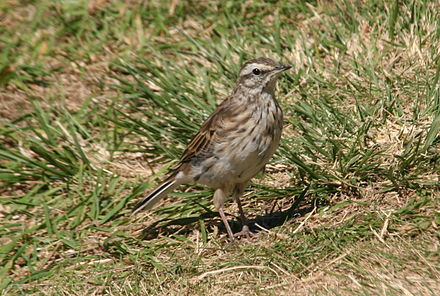Pipit
The pipits are a cosmopolitan genus, Anthus, of small passerine birds with medium to long tails. Along with the wagtails and longclaws, the pipits make up the family Motacillidae. The genus is widespread, occurring across most of the world, except the driest deserts, rainforest and the mainland of Antarctica.
They are slender, often drab, ground-feeding insectivores of open country. Like their relatives in the family, the pipits are monogamous and territorial. Pipits are ground nesters, laying up to six speckled eggs.
The genus Anthus was introduced in 1805 by the German naturalist Johann Matthäus Bechstein.[1] The type species was later designated as the meadow pipit.[2]The genus name Anthus is the Latin word for a small bird of grasslands mentioned by Pliny the Elder.[3]
Molecular studies of the pipits suggested that the genus arose in East Asia around seven million years ago (mya), during the Miocene, and that the genus had spread to the Americas, Africa and Europe between 5 and 6 mya. Speciation rates were high during the Pliocene (5.3 to 2.6 mya ) but have slowed down so during the Pleistocene.[4] Repeated dispersal between continents seems to have been important in generating new species in Eurasia, Africa and North America, rather than species arising by radiation once a continent was reached. In South America, however, vicariance appears to have played an important role in speciation.[4]
The genus has more than forty species, making it the largest genus in terms of numbers in its family. The exact species limits of the genus are still a matter of some debate, with some checklists recognising only 34 species. For example, the Australasian pipit, Anthus novaeseelandiae, which is currently treated as nine subspecies found in New Zealand, Australia and New Guinea, once also included the Richard's pipit and paddyfield pipit of Asia, and the African pipit of Africa. In addition it has been suggested that the Australian and New Zealand populations be split,[5] or even that New Zealand's subspecies found on its outlying Subantarctic Islands be split from the mainland species.[6] In part the taxonomic difficulties arise due to the extreme similarities in appearance across the genus.
Within the family there is an additional species, the golden pipit, Tmetothylacus tennelus, which belongs to a distinct, monotypic genus. This species is apparently intermediate in appearance between the pipits and the longclaws, and is probably more closely related to the longclaws. One species of pipit, the yellow-breasted pipit, is sometimes split out into a genus Hemimacronyx, which is considered to be intermediate between the longclaws and pipits. The split was originally proposed based on morphological features but it has also found support based upon genetic analysis.[7]


